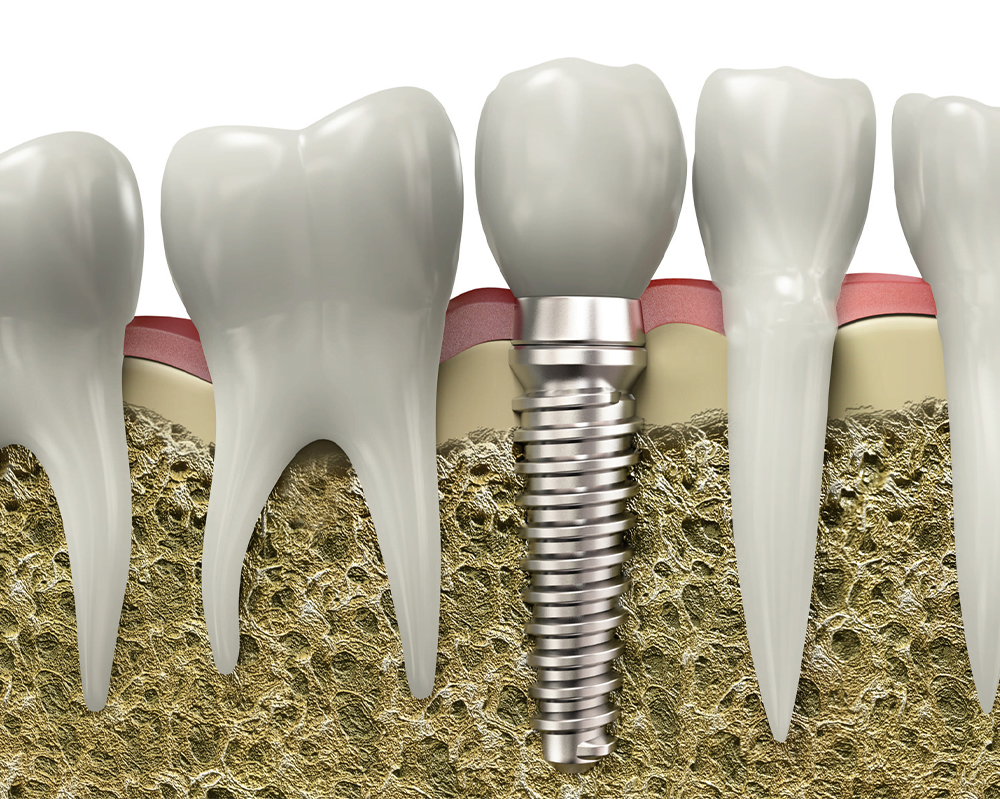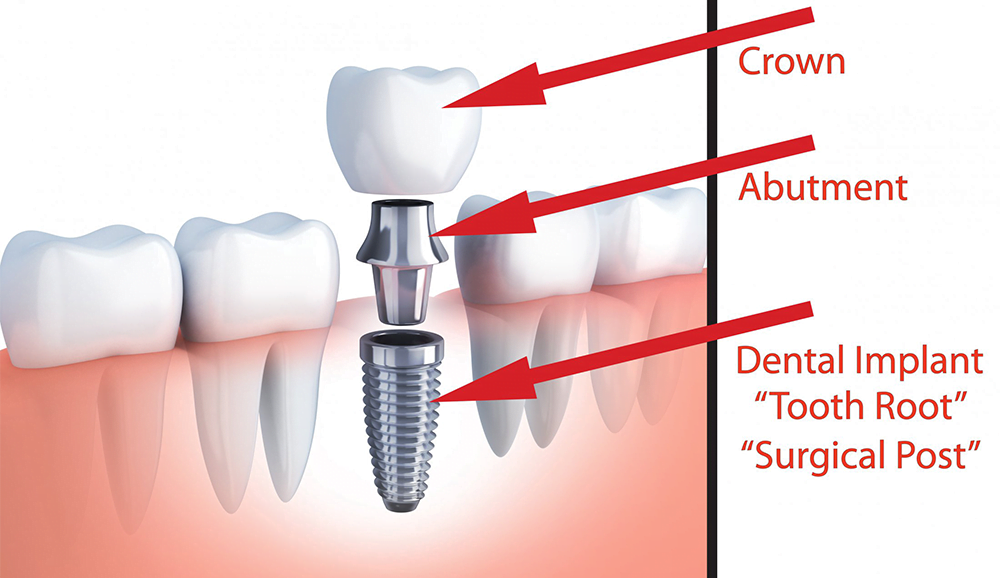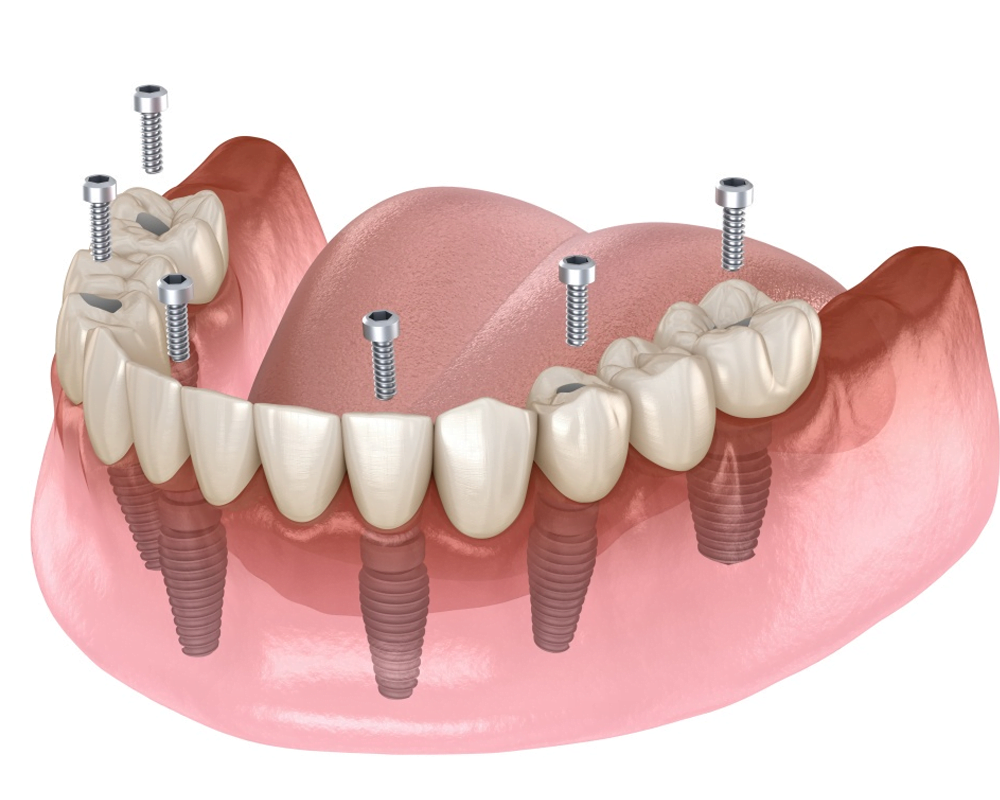
Dental implants are artificial tooth roots made of bio-compatible titanium which are inserted in the jaw to form the basis for a prosthetic restoration.
A dental implant is a good, biological way to replace a missing tooth placed in the bone .
You can chew normally, smile with confidence, and care for your teeth just the way you always have with dental implants.
The main advantage of an implant is to leave the natural healthy teeth on the either side of the space of the missing tooth . The teeth on either side can be left untreated, whereas, the placement of a dental, fixed bridge may require those teeth to have crowns placed on them.
With most current implant surgery techniques, there is a healing period after the implant has been placed. The healing period is normally 2-3 months before a crown can be placed on the implant but due to the type of the bone or the type of the implant immediate loading can be done for some cases.
After placing the implants in to the jaw bone we need time for healing of the bone cells that are getting connection to the implants . This process is called osseointegration and is the most important part of the implant treatment.
The phenomenon of the procedure lies in the fact that titanium is biocompatible – it does not induce any immune reactions when inserted in the bone. The implants become an integral part of the body that the presence of the implant is as natural as the presence of a natural tooth.
Dental implants can be used to support a single crown, a bridge or a denture (prosthesis).
Implant treatment is most often done in two steps:
Step 1: Surgical procedure
The implantation procedure is usually performed under local anaesthesia.
The implant has a screw-like shape, and is made of titanium. After placing an implant a special lid will be placed on the implant for protection of the connection part of the over prosthetic part .That will be left in the bone to heal stitches will be made over and will be covered by the gum.

Step 2: Prosthetic treatment
Once the titanium screw has healed into the bone, which normally takes 2-3 months, it can be used as an artificial root (or anchor) for the new crown. Implants can also be used to anchor bridges of different lengths, and removable dentures.
Properly placed and maintained, they last a lifetime provided that you brush and floss and when applicable use interproximal brushes.
Advantages of Dental Implants compared to fixed bridges and removal dentures:
An implant anchored tooth or bridge looks and feels like your own teeth. They are anchored in the bone.
The presence of implants in the jaw bone prevents the normal bone resorption (shrinking) that otherwise always occurs after teeth have been removed. This shrinking of the jaw bone is a serious long-term problem for patients who have had all their teeth extracted.
Implants do not require any work on adjacent teeth. By contrast, a dental bridge requires preparing (grinding) of the adjacent teeth for crowns. Removable partial dentures require some grinding of adjacent teeth and the fitting of clasps and rests on them, which can catch food.
Since dental implants are permanently anchored in the bone, any prosthetic restoration fixated to the implants will be securely anchored, unlike a removable prosthesis where there is always some degree of mobility.
Disadvantages of implant treatment:
They may be more expensive than other types of tooth replacement.
If you only have one or two missing teeth and if the teeth adjacent to those spaces already have or need crowns, there is less advantage with implant treatment.
Implant treatment involves a longer period of time from start to finish.

ALL ON 4 / ALL ON 6 IMPLANT SYSTEMS
All on 4 / All on 6 implant systems are helping patients regain their confidence back and enjoy the eating and chewing functions without the discomfort of removable prothesis
All on 4 implants is a technique used when the patient needs full arch reconstruction. The process involves placing only 4 individual implants; two straight anterior implants and two implants tilted up to 45deg in the posterior back part. That provides the patient a fixed full-arched prothesis with immediate loading on the day of surgery.

All on 6 implants is a technique of a full mouth restoration solution where 6 implants are placed to hold up the 14 unit bridge. All on 6 implant techique is biomechanically stronger then all on 4 system and also more cost-effective due to efficiency and the stability of the technique.
The treatment also preffered by patient with the severe gum disease when the bone requires stronger support.
Both All on 4 / All on 6 implant systems provide a fast solution with immediate loading on the same day and to a achive comfortable lifestyle and natural looking teeth.
ARE YOU A CANDIDATE FOR DENTAL IMPLANTS?
Dental implants are the best opinion for people of all ages in good general oral health who have lost a tooth or teeth due to an accident,gum disease,an injury or some other reason.It is important that you have enough dental bone to support the implant.There are some health conditions that warrant special concideration.Certain chronic diseases,heavy smoking or alcohol problems contraindicate implant treatment.Age is not a factor for the implant placing.
WHY IMPLANTS?
Implants have many advantages comparing to the other prosthetic treatments:
Implants improve the quality of your life;
You can enjoy all food varieties,
You can forget the dentures with their disgusting adhesives,
The implants are felt as real teeth, and function likewise – they are stable,
Dental implants allow for more self-confidence due to lack of awkward situations with loosened dentures.The eating function will be more comfortable.
Improved appearance;
Dental implants prevent bone atrophy and therefore help maintain the natural gum contour as well as the jaw bone and face shape.
Improved health;
Implants make chewing easier and subsequently influence digestion,
Their presence limits the possibility of damage to adjacent healthy teeth.
Oral care for implants is the same as for natural teeth.
THE TREATMENT INFORMATION AND THE PROCEDURES
1 Consultation and planning
Prior to the surgical part of the implant procedure it is necessary to establish an individual, detailed treatment plan as to the number and placement of the dental implants required to supplement the teeth losses. The treatment plan considers individual characteristics of the patient, like the location of the sinuses and nerves, and the jawbone condition. The dentist requires at this stage a two-dimensional panoramic image of the patient’s face and a three-dimensional image of the chosen bone fragment, to picture the bone thickness at the place of the planned implantation. In more complicated cases, a full 3D tomography is required.
2 Bone preparation and implantation
If the bone conditions ( thickness, height and density) in place of the intended implantation are not sufficient, an additional treatment needs to be performed – procedure-driven bone grafting (augmentation) or sinus lift. The bone regeneration period after such a treatment lasts from 6 to 10 months, the implantation can proceed after this time. If the bone conditions are adequate and there are no other contraindications, the implantation treatment can commence at once. The main procedure is the insertion of the titanium root part of the prosthetic restorative into the bone socket of the missing tooth, which is subsequently sealed with a special protective screw. All this is performed during one visit.
Post – treatment advice
– Antibiotic and painkillers as prescribed by the dentist,
– Cold compress in the early post-operative period is advised,
– Diet restricted to soft foods only,
– Mouth rinsing with a special fluid prescribed by the dentist ( chlorhexidine gluconate 0,2%),
– Avoiding heavy lifting during the period specified by the dentist (until the removal of stitches),
– During the first 48 hours, smoking should be reduced,
– Following all doctors’ orders and follow-up visits is a must.
3 Prosthetic crown attachment
After the period of osseointegration (implant bonding with the bone), lasting from 3 to 6 months, the dentist will uncover the implant/s and replace the sealing screws on the implant with an abutment. The purpose of that is to prepare and sculpt the gums for future prosthesis (crown or bridge). After approx.. 2 weeks, the dentist takes impressions and conveys them to the laboratory where the prosthetic restoration is produced. The restoration is then attached to the implant either by screwing or cementing.
Two stage procedure (most commonly performed)– The two stage procedure requires two surgeries. During the first stage, the titanium screw is placed in the jaw bone. Special protecting screws are placed on top of the implant, and healing caps to sculpt the gums. After the osseointegration process, after the surgery has healed, an abutment is placed on the implant, and dental impressions are taken. In the end, the individually prepared crown is placed on the abutment.
Single stage procedure– in the case of very good bone conditions single stage dental implants are used. The insertion of the implant screw and the placement of a temporary prosthetic crown is being performed during one visit.
Oral hygiene:
Self- discipline at effective home oral care and following strictly the dentist’s prescriptions are the key for maintaining the implants for a lifetime without problems. The patient is expected to maintain good oral hygiene to prevent inflammation of supporting tissues. Teeth brushing is absolutely compulsory. A close cooperation with your dentist after the procedure and strictly attending the follow-up visits is a prerequisite for the warranty for your new teeth. The implant prothesis may need extra dental care for a proper hygiene.Brushing, flossing and rinsing with special oral mouthwashes, although required, are often insufficient. Therefore, systematic dental check-ups are also required for professional teeth cleaning. Check-up visits at your dentist are also required to assess the implant status and evaluate whether the titanium screws do not require further actions.

